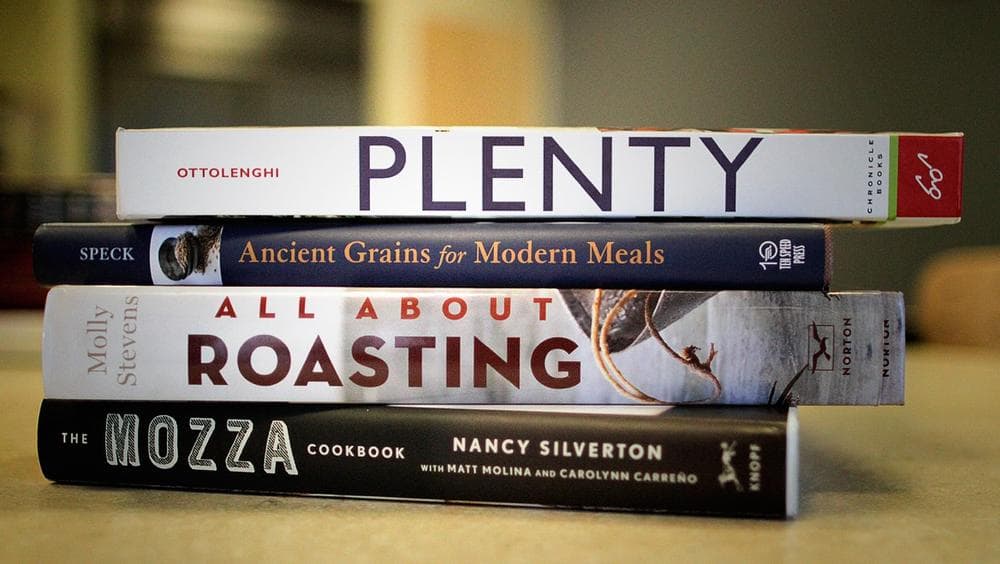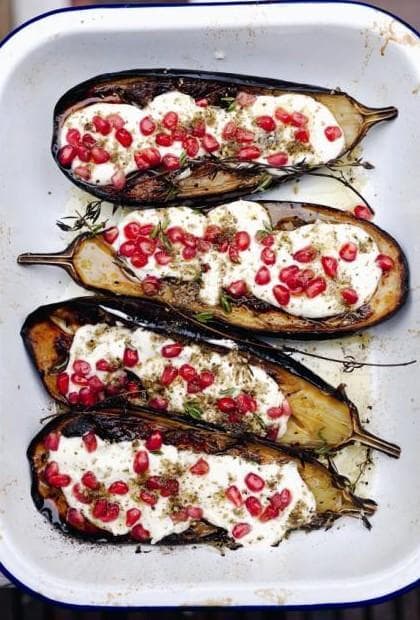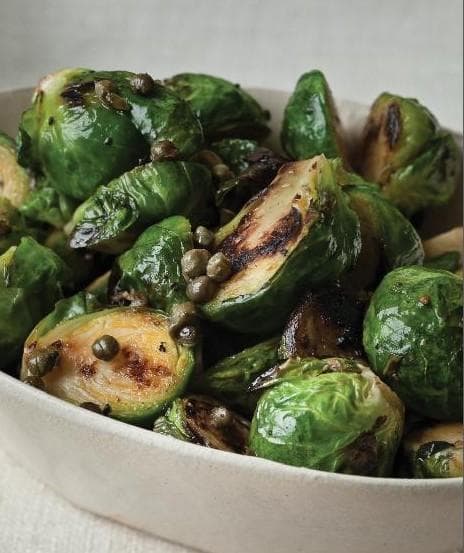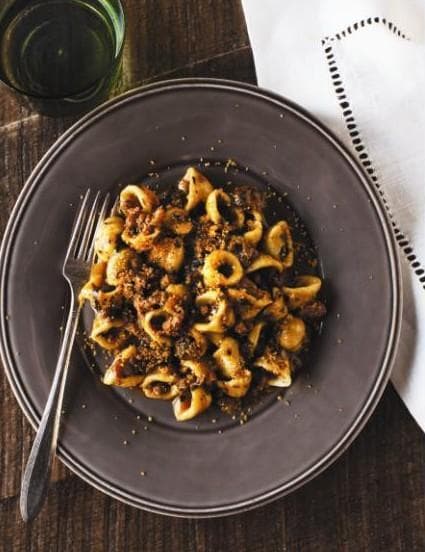Advertisement
Chef Kathy Gunst's Cream Of The Crop Cookbooks
Resume
Just in time for last minute holiday shopping, our resident chef Kathy Gunst picks her favorite cookbooks of the past year.
Yotam Ottolenghi's "Plenty: Vibrant Vegetable Recipes from London's Ottolenghi" was Kathy's favorite, she found it "thrilling" and says she couldn't stop cooking from it.
Kathy's Favorite Cookbooks Of 2011:
- "Plenty: Vibrant Vegetable Recipes from London’s Ottolenghi by Yotam Ottolenghi," published by Chronicle Books.
- "Ancient Grains for Modern Meals: Mediterranean Whole Grain Recipes for Barley, Farro, Kamut, Polenta, Wheat Berries and More" by Maria Speck published by Ten Speed Press, an imprint of the Crown Publishing Group.
- "All About Roasting: A New Approach to the Classic Art" by Molly Stevens, published by W.W. Norton & Company
- "The Mozza Cookbook: Recipes from Los Angeles’ Favorite Restaurant and Pizzeria" by Nancy Silverton, Matt Molina and Carolynn Carreno
Kathy Also Recommends:
- "The Food of Morocco," by Paula Wolfert, published by Ecco
- "The Food of Spain" by Claudia Roden, published by Ecco
- "Mourad: New Moroccan" by Mourad Lahlou, published by Artisan.
- (We also recommend: "Notes From a Maine Kitchen: Seasonally Inspired Recipes” by Kathy Gunst.
Kathy tells us that she looks at some sixty to eighty cookbooks every year, but her main criteria is that the recipes have to be flawless, if they don't work "it's just pretty pictures on glossy paper."
Below you'll find recipes for eggplant with buttermilk and carrot slaw from “Plenty,” creamy farro from “Ancient Grains," roasted brussels sprouts from “All About Roasting,”and orrechiate with sausage and fennel from “The Mozza Cookbook."
But we start with Kathy's recipe for creamed spinach, the dish that makes the holidays special for her.
What's your favorite recipe for the holidays? Tell us in the comments section.
Creamed Spinach With Nutmeg (pdf/printer friendly)
By: Kathy Gunst
[sidebar title="Kathy's Note" width="600" align="center"]This recipe has a long legacy in our family, beginning with my father who never loved vegetables but adored creamed spinach. During the holidays we make it with heavy cream and freshly ground nutmeg; over the years, I’ve lightened it up a bit. Instead of heavy cream I substitute local yogurt, or a thick Greek-style yogurt. If you don’t have either of those you can take plain yogurt and place it in a tightly meshed sieve for an hour or so until much of the liquid is released and drained and you’re left with a thick yogurt mixture. Look for whole nutmeg and a little nutmeg grater (or you can use the very tiny holes on a box cheese grater); it makes a huge difference. You can easily double or triple the recipe to serve a larger crowd.[/sidebar]
About 2 tablespoons olive oil
1 pound fresh spinach or baby spinach, washed and thoroughly dried (if stems are very thick and long they can be removed)
2 to 3 cloves garlic, finely chopped
Salt and freshly ground black pepper
1/4 to 1/2 teaspoon freshly ground nutmeg, or more
1/2 cup heavy cream or plain regular or low-fat yogurt
TIP: You can also add all kinds of different spices: add a dash of cardamom, allspice, chile flakes, or cayenne.
In a large skillet heat 1/2 tablespoon of the oil over high heat. Add half the garlic and cook for 30 seconds. Add half the spinach and cook, stirring, for about 2 to 3 minutes, or until wilted but not necessarily cooked through. Remove to a bowl. Add another tablespoon of the oil and add the remaining garlic and cook 30 seconds. Add the remaining spinach and sauté in the same manner; seasoning with salt, pepper and nutmeg. Place in the bowl.
Chop the spinach (some like it finely chopped and others coarsely chopped) or if using baby spinach leave it whole.
Add the cream (or yogurt) to the hot skillet and cook over low heat. The heavy cream needs to reduce to be thick enough to coat a spoon; let simmer about 3 to 4 minutes. The yogurt simply needs to heat through and thin out a little; cook about 2 minutes. Add the spinach, more salt, pepper and nutmeg to taste and stir well to make sure the spinach is well coated with the cream or yogurt.
From Notes from a Maine Kitchen (Down East Books, 2011) by Kathy Gunst
Eggplant With Buttermilk And Carrot Slaw From “Plenty: Vibrant Vegetable Recipes From London’s Ottolenghi” (pdf/printer friendly)
By: Yotam Ottolenghi
[sidebar title="Chef's Note" width="600" align="center"]I can’t think of a more rustically elegant (is that a contradiction in terms?) starter. Serve with some robust white bread or pita and you are, literally, in food heaven. In the recipe you’ll find Sami Tamimi’s technique for getting the seeds out of the pomegranate, which I am afraid is now a very well-known secret.[/sidebar]

Serves 4 as a starter
2 large and long eggplants
1/3 cup olive oil
1½ tsp lemon thyme leaves, plus a few whole sprigs to garnish
Maldon sea salt and black pepper
1 pomegranate
1 tsp za’atar
Sauce
9 tbsp buttermilk
½ cup Greek yogurt
1½ tbsp olive oil, plus a drizzle to finish
1 small garlic clove, crushed
pinch of salt
Preheat the oven to 400°F. Cut the eggplants in half lengthways, cutting straight through the green stalk (the stalk is for the look; don’t eat it). Use a small sharp knife to make three or four parallel incisions in the cut side of each eggplant half, without cutting through to the skin. Repeat at a 45-degree angle to get a diamond-shaped pattern.
Place the eggplant halves, cut-side up, on a baking sheet lined with parchment paper. Brush them with olive oil – keep on brushing until all of the oil has been absorbed by the flesh. Sprinkle with the lemon thyme leaves and some salt and pepper. Roast for 35 to 40 minutes, at which point the flesh should be soft, flavorful and nicely browned. Remove from the oven and allow to cool down completely.
While the eggplants are in the oven, cut the pomegranate into two horizontally. Hold one half over a bowl, with the cut side against your palm, and use the back of a wooden spoon or a rolling pin to gently knock on the pomegranate skin. Continue beating with increasing power until the seeds start coming out naturally and falling through your fingers into the bowl. Once all are there, sift through the seeds to remove any bits of white skin or membrane.
To make the sauce. Whisk together all of the ingredients. Taste for seasoning, then keep cold until needed.
To serve, spoon plenty of buttermilk sauce over the eggplant halves without covering the stalks. Sprinkle za’atar and plenty of pomegranate seeds on top and garnish with lemon thyme. Finish with a drizzle of olive oil.
Spicy Moroccan Carrot Salad
[sidebar title="Chef's Note" width="600" align="center"]There are countless variations on this gutsy salad, all incorporating sweet spices, fresh herbs and some sort of lemony kick. My version is intense and will go well as one component in a feast of Middle Eastern salads, or just to accompany fried fish. You can serve it warm, as well as cold, with Freekeh Pilaf (page 241) for instance.[/sidebar]
Serves 4
2 pounds of carrots
1/3 cup olive oil, plus extra to finish
1 medium onion, finely chopped
1 tsp sugar
3 garlic cloves, crushed
2 medium green chiles, finely chopped
1 green onion, finely chopped
1/8 tsp ground cloves
¼ tsp ground ginger
½ tsp ground coriander
¾ tsp ground cinnamon
1 tsp sweet paprika
1 tsp ground cumin
1 tbsp white wine vinegar
1 tbsp chopped preserved lemon
salt
2½ cups cilantro leaves, chopped, plus extra to garnish
½ cup Greek yogurt, chilled
Peel the carrots and cut them, depending on their size, into cylinders or semicircles ½ inch thick; all the pieces should end up roughly the same size. Place in a large saucepan and cover with salted water. Bring to the boil, then turn down the heat and simmer for about 10 minutes or until tender but still crunchy.
Drain in a colander and leave to dry out.
Heat the oil in a large pan and sauté the onion for 12 minutes on a medium heat until soft and slightly brown. Add the cooked carrots to the onion, followed by all the remaining ingredients, apart from the cilantro and yogurt. Remove from the heat. Season liberally with salt, stir well and leave to cool.
Before serving, stir in the cilantro, taste and adjust the seasoning if necessary. Serve in individual bowls with a dollop of yogurt, a drizzle of oil and garnished with the extra cilantro.
Reprinted from "Plenty: Vibrant Vegetable Recipes from London’s Ottolenghi," by Yotam Ottolenghi, Chronicle Books.
Creamy Farro From 'Ancient Grains' (pdf/printer friendly)
By: Maria Speck

Serves 4
Farro
2 cups water
1 cup farro
1 teaspoon anise seeds
1 (1-inch) piece cinnamon stick
Pinch of fine sea salt
Roasted grapes
3 cups seedless red grapes
(11/4 pounds)
1 teaspoon extra-virgin olive oil
4 tablespoons honey, plus extra for serving
1/2 cup heavy whipping cream or half-and-half
1/2 teaspoon vanilla extract
Ground cinnamon, for sprinkling
1.) To prepare the farro, bring the water, farro, anise seeds, cinnamon stick, and salt to a boil in a heavy-bottomed 4-quart saucepan. Decrease the heat to maintain a simmer, cover, and cook until the farro is tender but still slightly chewy, 20 to 25 minutes. Remove the cinnamon stick, drain any remaining liquid, and return the farro to the saucepan.
2.) Meanwhile, prepare the roasted grapes. Position a rack 6 inches from the heat source and preheat the broiler for 5 minutes. Spread the grapes on a large rimmed baking sheet. Drizzle with the olive oil and 2 tablespoons of the honey and toss to combine. Broil until the grapes just start to shrivel and release some juices as they burst, 5 to 7 minutes. Immediately transfer the grapes with their juices to a heatproof bowl.
3.) To finish, add the cream and vanilla extract to the farro and bring to a boil over medium heat, stirring frequently. Cook until the cream thickens slightly, 3 to 5 minutes. Stir in the remaining 2 tablespoons honey, add the grapes with their juices and cook just long enough to reheat the fruit, about 2 minutes. Divide among bowls, sprinkle with cinnamon, and serve warm with more honey on the side.
to get a head start: Make the farro, as in step 1, ahead (see page 25). The grapes can also be roasted 1 day ahead. Chill, covered. To vary it: If you like a bit more chewiness, try other berries from the wheat family such as spelt, Kamut, or soft whole wheat. You will need a scant 3 cups (for cooking instructions, see page 25).
From “Ancient Grains for Modern Meals: Mediterranean Whole Grain Recipes for Barley, Farro, Kamut, Polenta, Wheat Berries, & More," copyright Ten Speed Press.
Roasted Brussels Sprouts with Capers and Lemony Browned Butter from 'All About Roasting' (pdf/printer friendly)
[sidebar title="Chef's Note" width="600" align="center"]Imagine Brussels sprouts were on the list of most hated vegetables for many of my generation growing up, but that’s only because our mothers didn’t know to splash the mini-cabbagey vegetables with olive oil and roast them in a hot oven until they were utterly tender and sweet. Gone are any traces of the slippery texture we associate with cabbage and, best of all, that strong sulfurous smell. In fact, these sprouts taste so good that you may have to restrain yourself from popping one after another into your mouth before they hit the table.Roasted Brussels sprouts are wonderful on their own, and I often prepare them that way, but here’s how I make them when I want a real show-stopper: As the sprouts roast, brown up a few tablespoons of butter in a skillet, add some capers and lemon, and toss this over the sprouts before serving. The contrast between the earthy vegetables and the sprightly lemon-caper dressing makes them irresistible.
Serve these alongside everything from roast beef to the Thanksgiving turkey. I’ve even been known to make supper out of a poached egg, a few slices of crisp bacon, and a generous serving of roasted sprouts. Thankfully, the recipe is easily doubled (or tripled), although if you roast more than 1 1/2 pounds, you will have to use 2 baking sheets in order to give the sprouts plenty of room to brown up during roasting. If you make these ahead, keep them at room temperature and add the browned butter at the last minute.[/sidebar]

SERVES 4
Method: High heat
Roasting time: 20 to 25 minutes
1 pound Brussels sprouts, trimmed
2 tablespoons extra-virgin olive oil
Kosher salt and freshly ground black pepper
3 tablespoons unsalted butter
1 teaspoon mustard seeds, yellow or brown
2 tablespoons capers, drained
1 teaspoon fresh lemon juice, plus more if needed
1.) Heat the oven. Position a rack in the center of the oven and heat to 425 degrees (400 degrees convection). If desired, line a heavy-duty rimmed baking sheet with parchment paper.
2.) Cut and season the Brussels spouts. Depending on their size, cut the Brussels sprouts in halves or quarters; you want them to be small enough to be bite-sized. Place in a large bowl and toss with the olive oil and salt and pepper to taste. Arrange the sprouts in a single layer on the baking sheet. Don’t worry if some of the leaves fall off. Include these when roasting; they will crisp up, adding a nice crunch to the dish.
3.) Roast. Slide the Brussels sprouts into the oven and roast, turning once or twice with a metal spatula to promote even cooking, until the sprouts are tender throughout and smaller bits or leaves that have fallen off are browned and crunchy, 20 to 25 minutes. Test for doneness by piercing a sprout with the tip of a paring knife, but to be sure, nab one off the baking sheet, let it cool slightly, and taste; it should be tender and sweet.
4.)Meanwhile, make the browned butter. As the sprouts roast, melt the butter in a small skillet or heavy saucepan (it should be no more than 6 inches across or the butter will burn). Cook over medium heat until the butter is melted. Add the mustard seeds, increase the heat to medium-high, and cook, watching the pan carefully and swirling frequently, until the butter begins to foam and turns golden brown, about 2 minutes. Add the capers and lemon juice—the butter will sizzle—and immediately remove from the heat. Season with salt and pepper to taste and keep warm until the Brussels sprouts are ready.
5.) Serve. Transfer the Brussels sprouts to a serving dish and add the browned butter. Toss to coat. Taste for salt, pepper, and lemon and serve immediately.
Reprinted from "All About Roasting: A New Approach to the Classic Art" by Molly Stevens. Copyright (c) 2011 by Molly Stevens. Photographs (c) 2011 by Quentin Bacon. With permission of the publisher, W.W. Norton & Company.
Orrechiate with Sausage and Fennel and Swiss Chard from 'The Mozza Cookbook' (pdf/printer friendly)
By: Nancy Silverton with Matt Molina and Carolynn Carreno
[sidebar title="Chef's Note" width="600" align="center"]Before we opened the Osteria, Matt made all of the dishes he wanted to put on the pasta menu for us to taste together. When he made this dish— his version of a classic from Puglia— that’s when I was absolutely convinced that the pasta program we were committing to was a good idea, and that Matt was absolutely the one to execute it. Evidently I’m not alone because this has been our most popular pasta since the day we opened. The chard you will prepare for this dish makes much more than you will need for four servings, as does the Fennel Sausage recipe. It would be a good recipe to double and serve to a crowd—just remember to prepare the sauce and toss it with the pasta in two separate sauté pans.[/sidebar]

Serves 4
1 bunch Swiss chard
1⁄4 cup extra- virgin olive oil
Kosher salt
1⁄2 large yellow Spanish onion, thinly sliced
12 garlic cloves, thinly sliced lengthwise
2 dried arbol chiles
for finishing and serving the pasta
3⁄4 pound Fennel Sausage
1⁄2 teaspoon Aleppo pepper
1 cup Basic Chicken Stock, or 1⁄4 cup salted pasta water mixed with 1⁄4 cup plain water
3 tablespoons unsalted butter
Kosher salt
12 ounces Orecchiette
3 tablespoons finishing- quality extra- virgin olive oil
1⁄4 cup plus 2 tablespoons freshly grated Parmigiano- Reggiano
2 teaspoons fennel pollen
2 tablespoons Toasted Bread Crumbs
1.) To prepare the chard, pull the leaves from the ribs. Roughly chop the leaves and set aside. Cut off and discard the very ends of the ribs and slice the ribs 1⁄4 inch thick.
2.) Heat the olive oil in a large sauté pan over medium- high heat until it is almost smoking and slides easily in the pan, 2 to 3 minutes. Add the chard ribs, season with salt, and sauté for 2 to 3 minutes, until barely translucent. Add the onion, garlic, and chiles, and season with salt.
3.) Sauté the vegetables for about 10 minutes, adding water to the pan (as much as 1 cup total), stirring often to prevent the vegetables browning. (You add water to the pan so you can sauté and sweat the onion without browning it, but you never want the onion swimming in water—just enough so the pan isn’t dry.)
4.) Add the chard leaves, season with salt, and fold the leaves in with the onion for 1 or 2 minutes to wilt them slightly. Reduce the heat to low, cover, and cook for 15 to 20 minutes, stirring from time to time, until the chard leaves are very dark green and the onion, leaves, and stems are one soft, homogenous mixture.
5.) Turn the vegetables out onto a cutting board and chop, cutting first in one direction and then perpendicular to the first direction, until the vegetables are finely chopped to the point of being almost pureed. Measure out a heaping 1⁄4 cup of the vegetables for the pasta dish. Use the rest as an excuse to prepare this dish again in the very near future, or spoon a heaping spoonful under a piece of grilled fish, topped with a spoonful of Salsa Verde.
6.) To make the sauce, heat a sauté pan over high heat for about 2 minutes until it’s very hot. Add the sausage to the pan and cook it undisturbed for about 2 minutes, until the meat is seared. Stir the meat and cook for another 4 minutes, breaking it into pea- size pieces, until it is cooked through. Add the chopped chard and cook for 2 to 3 minutes to warm it through, stirring the chard into the sausage as it cooks. Sprinkle the pepper over the chard and sausage, add the chicken stock, and cook the sauce for 2 minutes, stirring constantly, to bring the ingredients together. Add the butter, stir until it melts, and turn off the heat while you cook the pasta.
7.) Fill a pasta pot or large stockpot with 6 quarts of water, add 6 tablespoons of salt, and bring the water to a boil over high heat. If you are not using a pasta pot, place a colander in the sink or have a large wire strainer handy to lift the pasta out of the pot.
8.) Remove the orecchiette from the refrigerator or the freezer and drop them into the boiling water. Stir to prevent the pasta from sticking together, partially cover the pot so the water returns to a boil quickly and continues boiling, and cook the pasta until it’s al dente, about 2 minutes. About 1 minute before the pasta is done, place the sauce over high heat. Lift the pasta out of the cooking water or drain it and immediately add it to the pan with the sauce. Cook the pasta with the sauce together for 1 to 2 minutes, stirring with a rubber spatula, until the sauce is thick, adding fresh water to the pan if the pasta looks dry or sticky instead of slippery and glistening. Turn off the heat and add the finishing-quality olive oil, Parmigiano-Reggiano, and fennel pollen, stirring vigorously and shaking the pan to emulsify the sauce.
9.) Pile the orecchiette in the center of each of eight plates, dividing it evenly, and spoon any sauce left in the pan over the pasta. Sprinkle a generous tablespoon of bread crumbs over each serving, and serve with the remaining bread crumbs on the side.
Excerpted from THE MOZZA COOKBOOK by Nancy Silverton with Matt Molina and Carolynn Carreno. Copyright © 2011 by Nancy Silverton. Excerpted by permission of Knopf, a division of Random House. All rights reserved. No part of this excerpt may be reproduced or reprinted without permission in writing from the publisher.
Guest:
- Kathy Gunst, chef
This segment aired on December 20, 2011.
